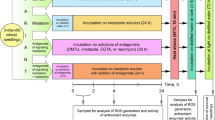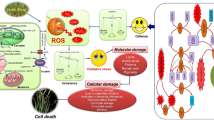Abstract
Abiotic stresses, such as high salinity or drought, can cause proline accumulation in plants. Such an accumulation involves proline transport into mitochondria where proline catabolism occurs. By using durum wheat seedlings as a plant model system, we investigated how proline enters isolated coupled mitochondria. The occurrence of two separate translocators for proline, namely a carrier solely for proline and a proline/glutamate antiporter, is shown in a functional study in which we found the following: (1) Mitochondria undergo passive swelling in isotonic proline solutions in a stereospecific manner. (2) Externally added l-proline (Pro) generates a mitochondrial membrane potential (ΔΨ) with a rate depending on the transport of Pro across the mitochondrial inner membrane. (3) The dependence of the rate of generation of ΔΨ on increasing Pro concentrations exhibits hyperbolic kinetics. Proline transport is inhibited in a competitive manner by the non-penetrant thiol reagent mersalyl, but it is insensitive to the penetrant thiol reagent N-ethylmaleimide (NEM). (4) No accumulation of proline occurs inside the mitochondria as a result of the addition of proline externally, whereas the content of glutamate increases both in mitochondria and in the extramitochondrial phase. (5) Glutamate efflux from mitochondria occurs at a rate which depends on the mitochondrial transport, and it is inhibited in a non-competitive manner by NEM. The dependence of the rate of glutamate efflux on increasing proline concentration shows saturation kinetics. The physiological role of carrier-mediated transport in the regulation of proline catabolism, as well as the possible occurrence of a proline/glutamate shuttle in durum wheat seedlings mitochondria, are discussed.








Similar content being viewed by others
Abbreviations
- AA:
-
antimycin
- AZC:
-
azetidine-2-carboxylate
- d-Pro:
-
d-proline
- DWM:
-
durum wheat seedling mitochondria
- GDS:
-
glutamate detecting system
- Glu:
-
l-glutamate
- MERS:
-
mersalyl
- NEM:
-
N-ethylmaleimide
- NADH-DH:
-
NADH dehydrogenase
- Pro:
-
l-proline
- P5C:
-
pyrroline-5-carboxylate
- P5CDH:
-
Δ1 pyrroline-5-carboxylate dehydrogenase
- P5CR:
-
Δ1 pyrroline-5-carboxylate reductase
- P5CS:
-
Δ1 pyrroline-5-carboxylate synthetase
- ProDH:
-
proline dehydrogenase
References
Adams E, Frank L (1980) Metabolism of proline and the hydroxyproline. Annu Rev Biochem 49:1005–1061
Atlante A, Passarella S, Pierro P, Di Martino C, Quagliariello E (1996) The mechanism of proline/glutamate antiport in rat kidney mitochondria. Energy dependence and glutamate-carrier involvement. Eur J Biochem 241:171–178
Atlante A, Passarella S, Pierro P, Quagliariello E (1994) Proline transport in rat kidney mitochondria. Arch Biochem Biophys 309:139–148
Armengaud P, Thiery L, Buhot N, Grenier-de March G, Savouré A (2004) Transcriptional regulation of proline biosynthesis in Medicago truncatula reveals developmental and environmental specific features. Physiologia Plantarum 120:442–450
Aubert S, Hennion F, Bouchereau A, Gout E, Bligny R, Dorne AJ (1999) Subcellular compartmentation of proline in the leaves of the subantarctic Kerguelen cabbage Pringlea antiscorbutica R. Br. In vivo 13C-NMR study. Plant Cell Environ 22:255–259
Ballantyne JS and Chamberlin ME (1993) Regulation of cellular amino acid levels. In: Strange K (ed) Cellular and molecular physiology of cell volume regulation, CRC Press Inc., Boca Raton, pp 111–122
Barile M, Brizio C, Valenti D, De Virgilio C, Passarella S (2000) The riboflavin/FAD cycle in rat liver mitochondria. Eur J Biochem 267(15):4888–4900
Chappell JB, Haarhoff KN (1967) Biochemistry of mitochondria. In: Slater EC, Kaniuga Z, Wotczak L (eds) Academic, London, pp 75–92
Demir Y (2000) Growth and proline content of germinating wheat genotypes under ultraviolet light. Turk J Bot 24:67–70
Di Martino C, Delfine S, Pizzuto R, Loreto F, Fuggi A (2003) Free amino acids and glycine betaine in leaf osmoregulation of spinach responding to increasing salt stress. New Phytologist 158:455–463
Elthon TE, Stewart CR (1982) Proline oxidation in corn mitochondria. Plant Physiol 70:567–572
Elthon TE, Stewart CR, Bonner WD (1984) Energetics of Proline transport in corn mitochondria. Plant Physiol 75:951–955
Fernie AR, Carrari F, Sweetlove LJ (2004) Respiratory metabolism: glycolysis, the TCA cycle and mitochondrial electron transport. Curr Opin Plant Biol 7:254–261
Forlani G, Scainelli D, Nielsen E (1997) Two Δ1-pyrroline−5-carboxylate dehydrogenase isoforms are expressed in cultured Nicotiana plimbaginifolia cells and are differentially modulated during the culture growth cycle. Planta 202:242–248
Gimpel JA, de Haan EJ, Tager JM (1973) Permeability of isolated mitochondria to oxaloacetate. Biochim Biophys Acta 292(3):582–591
Grallath S, Weimar T, Meyer A, Gumy C, Suter-Grotemeyer M, Neuhaus JM, Rentsch D (2005) The AtProT family. Compatible solute transporters with similar substrate specificity but differential expression patterns. Plant Physiol 137(1):117–126
Hamilton EW, Heckathorn SA (2001) Mitochondrial adaptations to NaCl. Complex I is protected by anti-oxidants and small heat shock proteins, whereas Complex II is protected by proline and betaine. Plant Physiol 126:1266–1274
Hare PD, Cress WA (1997) Metabolic implications of stress-induced proline accumulation in plants. Plant Growth Regul 21:79–102
Halestrap AP, Scott RD, Thomas AP (1980) Mitochondrial pyruvate transport and its normal regulation. Int J Biochem 11:97–105
Hong Z, Lakkineni K, Zhang Z, Verma DP (2000) Removal of feedback inhibition of Δ1-pyrroline-5-carboxylate synthetase results in increased proline accumulation and protection of plants from osmotic stress. Plant Physiol 122 (4):1129–1136
Igarashi Y, Yoshiba Y, Takeshita T, Nomura S, Otomo J, Yamaguchi-Shinozaki K, Shinozaki K (2000) Molecular cloning and characterization of a cDNA encoding proline transporter in rice. Plant Cell Physiol 41:750–756
Kishor KPB, Hong Z, Miao G, Hu CA, Verma DPS (1995) Overexpression of Δ1-pyrroline-5-carboxylate synthetase increases proline production and confers osmotolerance in transgenic plants. Plant Physiol 108:1387–1394
Kiyosue T, Yoshiba Y, Yamaguchi-Shinozaki K, Shinozaki K (1996) A nuclear gene encoding mitochondrial proline dehydrogenase, an enzyme involved in proline metabolism, is upregulated by proline but downregulated by dehydration in Arabidopsis. Plant Cell 8(8):1323–1335
Laloi M, (1999) Plant mitochondrial carriers: an overview. Cell Mol Life Sci 56(11–12):918–944
Lee YH, Tegeder M (2004) Selective expression of a novel high-affinity transport system for acidic and neutral amino acids in the tapetum cells of Arabidopsis flowers. The Plant J 40(1):60–74
Lowry OH, Rosebrough NJ, Farr AL Randall RJ (1951) Protein measurement with the Folin phenol reagent. J Biol Chem 193(1):265–275
Mestichelli LJ, Gupta RN, Spenser ID (1979) The biosynthetic route from ornithine to proline. J Biol Chem 254:640–647
Meyer J (1977) Proline transport in rat liver mitochondria. Arch Biochem Biophys 178:387–395
Minocha R, Long S (2004) Simultaneous separation and quantitation of amino acids and and polyamines of forest tree tissues and cell cultures within a single high-performance liquid chromatography run using dansyl derivatization. J Chromatography 1035(1):63–73
Moore AL, Bonner WD Jr (1982) Measurements of membrane potentials in plant mitochondria with safranine method. Plant Physiol 70:1271–1276
Nanjo T, Kobayashi M, Yoshiba Y, Kakubari Y, Yamaguchi-Shinozaki K, Shinozaki K (1999a) Antisense suppression of proline degradation improves tolerance to freezing and salinity in Arabidopsis thaliana. FEBS Lett 461:205–210
Nanjo T, KobayashiM, Yoshiba Y, Sanada Y,Wada K, Tsukaya H, Kakubari Y, Yamaguchi-Shinozaki K, Shinozaki K (1999b) Biological functions of proline in morphogenesis and osmotolerance revealed in antisense transgenic Arabidopsis thaliana. Plant J 18:185–193
Njagi EN, Olembo NK, Pearson DJ (1992) Proline transport by tsetse fly Glossina morsitans flight muscle mitochondria. Comp Biochem Physiol B 102(3):579–584
Ozturk L, Demir Y (2002) In vivo and in vitro protective role of proline. Plant Growth Regul 38:259–264
Parvanova D, Ivanov S, Konstantinova T, Karanov E, Atanassov A, Tsvetkov T, Alexieva V, Djilianov D (2004) Transgenic tobacco plants accumulating osmolytes show reduce oxidative damage under freezing stress. Plant Physiol Biochem 42:57–63
Passarella S, Atlante A, Valenti D, de Bari L (2003) The role of mitochondrial transport in energy metabolism. Mitochondrion 2:319–343
Pastore D, Di Martino C, Bosco G, Passarella S (1996) Stimulation of ATP synthesis via oxidative phosphorylation in wheat mitochondria irradiated with helium-neon laser. Biochem Mol Biol Int 39:149–157
Pastore D, Stoppelli MC, Di Fonzo N, Passarella S (1999a) The existence of the K+ channel in plant mitochondria. J Biol Chem 274:26683– 26690
Pastore D, Trono D, Passarella S (1999b) Substrate oxidation and ADP/ATP exchange in coupled durum wheat (Triticum durum Desf.) mitochondria. Plant Biosyst 133:219–228
Pastore D, Di Pede S, Passarella S (2003) Isolated durum wheat and potato cell mitochondria oxidize externally added NADH mostly via the malate/oxaloacetate shuttle with a rate thet depends on the carrier-mediated transport. Plant Physiol 133:2029–2039
Rasmusson AG, Soole KL, Elthon TE (2004) Alternative NAD(P)H dehydrogenases in plant mitochondria. Annu Rev Plant Biol 55:23–39
Schwacke R, Schneider A, van der Graaff E, Fischer K, Catoni E, Desimone M, Frommer WB, Flugge UI, Kunze R (2003) ARAMEMNON, a novel database for Arabidopsis integral membrane proteins. Plant Physiol 131(1):16–26
Serrano R (1996) Salt tolerance in plants and microorganisms: toxicity targets and defense responses. Int Rev Cytol 165:1–52
Scarpulla RC, Soffer RL (1978) Membrane-bound proline dehydrogenase from Escherichia coli. Solubilization, purification, and characterization. J. Biol. Chem. 253:5997–6001
Sivakumar P, Sharmila P, Saradhi PP (1998) Proline suppresses Rubisco activity in higher plants. Biochem Biophys Res Commun 252:428–432
Sivakumar P, Sharmila P, Saradhi PP (2001) Proline suppresses Rubisco activity by dissociating small subunits from holoenzyme. Biochem Biophys Res Commun 282:236–241
Skubatz H, Meeuse BJD, Bendich AJ (1989) Oxidation of proline and glutamate by mitochondria of the inflorescence of Voodoo Lily (Sauromatum guttatum). Plant Physiol 91:530–535
Smirnoff N, Cumbes QJ (1989) Hydroxyl radical scavenging activity of compatible solute. Phytochemistry 28:1057–1060
Trotel-Aziz P, Niogret MF, Larher FR (2000) Proline level is partly under the control of abscisic acid in canola leaf discs during recovery from hyper-osmotic stress. Physiol Plant 110:376–38
Trotel-Aziz P, Niogret MF, Deleu C, Bouchereau A, Aziz A, Larher FR (2003) The control of proline consumption by abscisic acid during osmotic stress recovery of canola leaf discs. Physiol Plant 117:213–221
Yoshiba Y, Kiyosue T, Nakashima K, Yamaguchi-Shinozaki K, Shinozaki K (1997) Regulation of levels of proline as an osmolyte in plants under water stress. Plant Cell Physiol 38:1095–102
Yu C, Claybrook DL, Huang AH (1983) Transport of glycine, serine, and proline into spinach leaf mitochondria. Arch Biochem Biophys 227(1):180–187
Acknowledgements
We thank Dr. G. Paventi for his continuous generous cooperation and Prof. D. Pastore for stimulating discussions at the early stage of this work. Critical reading by Prof. Shawn Doonan is gratefully acknowledged. This work was supported by the MIUR project, PRIN 2004—“Cross talk between organelles in response to oxidative stress and programmed cell death in plants”.
Author information
Authors and Affiliations
Corresponding author
Additional information
Catello Di Martino, Roberto Pizzuto these authors contributed equally to the paper
Rights and permissions
About this article
Cite this article
Di Martino, C., Pizzuto, R., Pallotta, M.L. et al. Mitochondrial transport in proline catabolism in plants: the existence of two separate translocators in mitochondria isolated from durum wheat seedlings. Planta 223, 1123–1133 (2006). https://doi.org/10.1007/s00425-005-0166-z
Received:
Accepted:
Published:
Issue Date:
DOI: https://doi.org/10.1007/s00425-005-0166-z




